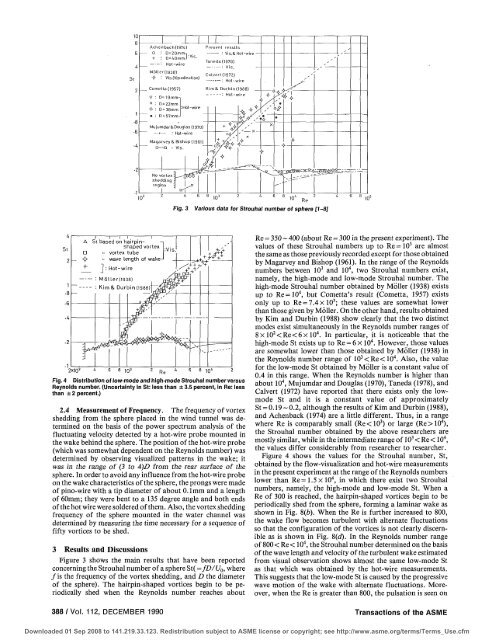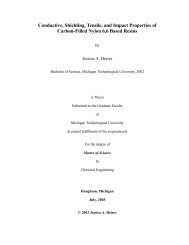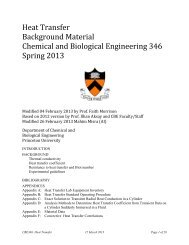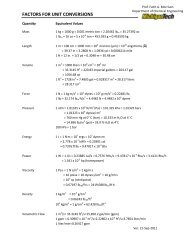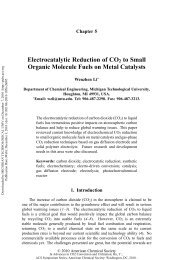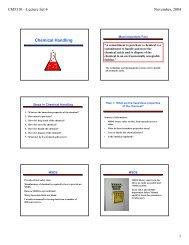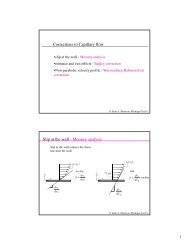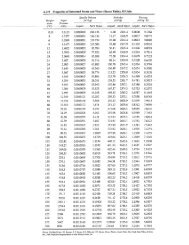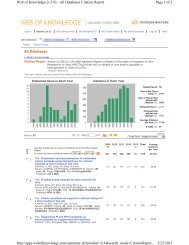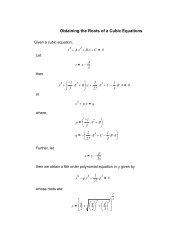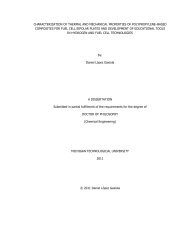A study on vortex shedding from spheres in uniform flow
A study on vortex shedding from spheres in uniform flow
A study on vortex shedding from spheres in uniform flow
Create successful ePaper yourself
Turn your PDF publications into a flip-book with our unique Google optimized e-Paper software.
6 B m3 2 4 6 8 ,„/. 2 4 6<br />
,U l0<br />
Re<br />
Fig. 3 Various data tor Strouhal number of sphere [1-8]<br />
Fig. 4 Distributi<strong>on</strong> of low-mode and high-mode Strouhal number versus<br />
Reynolds number. (Uncerta<strong>in</strong>ty <strong>in</strong> St: less than ± 3.5 percent, <strong>in</strong> Re: less<br />
than ± 2 percent.)<br />
2.4 Measurement of Frequency. The frequency of <strong>vortex</strong><br />
<strong>shedd<strong>in</strong>g</strong> <strong>from</strong> the sphere placed <strong>in</strong> the w<strong>in</strong>d tunnel was determ<strong>in</strong>ed<br />
<strong>on</strong> the basis of the power spectrum analysis of the<br />
fluctuat<strong>in</strong>g velocity detected by a hot-wire probe mounted <strong>in</strong><br />
the wake beh<strong>in</strong>d the sphere. The positi<strong>on</strong> of the hot-wire probe<br />
(which was somewhat dependent <strong>on</strong> the Reynolds number) was<br />
determ<strong>in</strong>ed by observ<strong>in</strong>g visualized patterns <strong>in</strong> the wake; it<br />
was <strong>in</strong> the range of (3 to A)D <strong>from</strong> the rear surface of the<br />
sphere. In order to avoid any <strong>in</strong>fluence <strong>from</strong> the hot-wire probe<br />
<strong>on</strong> the wake characteristics of the sphere, the pr<strong>on</strong>gs were made<br />
of p<strong>in</strong>o-wire with a tip diameter of about 0.1mm and a length<br />
of 60mm; they were bent to a 135 degree angle and both ends<br />
of the hot wire were soldered of them. Also, the <strong>vortex</strong> <strong>shedd<strong>in</strong>g</strong><br />
frequency of the sphere mounted <strong>in</strong> the water channel was<br />
determ<strong>in</strong>ed by measur<strong>in</strong>g the time necessary for a sequence of<br />
fifty vortices to be shed.<br />
3 Results and Discussi<strong>on</strong>s<br />
Figure 3 shows the ma<strong>in</strong> results that have been reported<br />
c<strong>on</strong>cern<strong>in</strong>g the Strouhal number of a sphere St( =fD/U 0 , where<br />
/is the frequency of the <strong>vortex</strong> <strong>shedd<strong>in</strong>g</strong>, and D the diameter<br />
of the sphere). The hairp<strong>in</strong>-shaped vortices beg<strong>in</strong> to be periodically<br />
shed when the Reynolds number reaches about<br />
Re = 350 ~ 400 (about Re = 300 <strong>in</strong> the present experiment). The<br />
values of these Strouhal numbers up to Re=10 3 are almost<br />
the same as those previously recorded except for those obta<strong>in</strong>ed<br />
by Magarvey and Bishop (1961). In the range of the Reynolds<br />
numbers between 10 3 and 10 4 , two Strouhal numbers exist,<br />
namely, the high-mode and low-mode Strouhal number. The<br />
high-mode Strouhal number obta<strong>in</strong>ed by Moller (1938) exists<br />
up to Re=10 4 , but Cometta's result (Cometta, 1957) exists<br />
<strong>on</strong>ly up to Re = 7.4xl0 3 ; these values are somewhat lower<br />
than those given by Moller. On the other hand, results obta<strong>in</strong>ed<br />
by Kim and Durb<strong>in</strong> (1988) show clearly that the two dist<strong>in</strong>ct<br />
modes exist simultaneously <strong>in</strong> the Reynolds number ranges of<br />
8x 10 2


